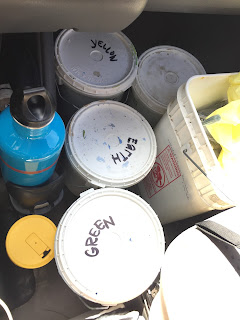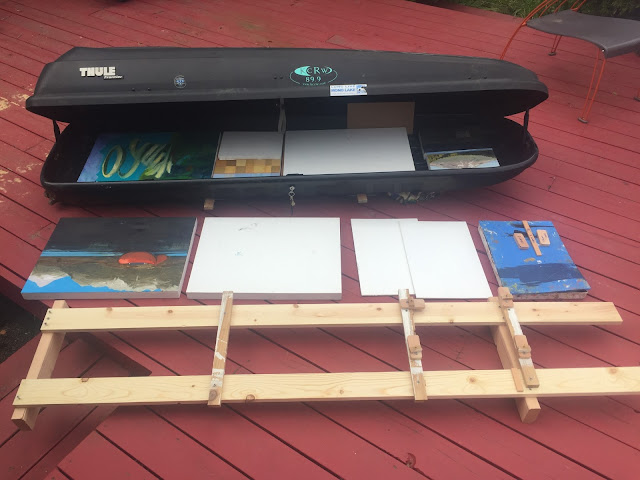 |
| I organize my tubes of paint by color in old gesso buckets for easy access when loading my pack and to prevent leakage in my van |
I have been avidly camping for most of my life, and feel
comfortable outdoors. I enjoy hiking, fishing, kayaking and generally prefer
living outdoors in the warmer months.
I “camp” in my van and generally stick to campsites.
My camping practice does not deviate too much from these
aforementioned outdoor activities, but plen air oil painting while camping
takes my outdoor logistics to a new level.
The joy of using oil paints outside is their slow drying
time.
For me, there is nothing like using oil paints. I like to compare the tactile sensation
of painting with oils like pushing beautifully colored, soft butter across a
surface. Pretty exquisite. To be able to do this for hours with my
feet planted in a Central or Eastern Oregon sagebrush is very satisfying.
But there are drawbacks and limitations.
Unlike watercolor or other water-based paint, oil paints
require harsh chemicals for clean up and offload toxic fumes when drying. Since I am camping out of my van I
needed to figure out:
- Storage of numerous drying paintings and limit my exposure to the fumes in my van, during my month long road trip.
- How to hike and paint, so that I am not attached to the van.
- The clean up and disposal of paints and brushes
My solution, as I am ever thrifty, is to use what I
have. The rooftop auto storage box
that I have had for years is the storage solution that I utilize for my
paintings. In the past, I have successfully used this roof box to lay a single
layer of panels/canvas with a few chucks here and there to prevent
shifting-worked great. But since
this trip is longer, I created two layers to accommodate more paintings and
large format canvases.
Using a chop saw, 2 x 4’s, 1 x 4’s, screws and a drill I
created an internal rack for the roof box. If you have any experience building
simple wood objects this should be a cinch. The hardest part was working with
different dimensions of canvases. If you standardize the size and type of your
painting surfaces it will make things much easier.
 |
| Ten panels and my blue palette fit! (yes, I paint over older paintings) |
 |
| Niffy little "swing arms" that make taking out panels easy. |
So far, this system has been working great. I have been driving on some
serious washboard roads and my paintings have been staying in place.
Cleaning up after oil painting is a pain in the butt, I will
not lie. It is the last thing that
I want to do after I have been painting in the harsh sun for hours. Because of this I have opted for a
pretty simple pack-it-out system.
I carry a small jar of turpentine with me to use while I am
painting. This is a standard jar
that you buy at an art store that has the metal coil on the inside. When I am
done painting I will wipe off as much paint from my brush as possible on a cloth
rag. (I use torn up old
t-shirts). I then slosh those
brushes in my “field” turpentine and try to get as much paint off a
possible. When I return back to
camp I then do the same thing with my brushes in another jar of much cleaner
turpentine. Since I am painting
with these brushes at least every couple of days this seems to do the
trick. When I return home I will
give these brushes a DEEP cleaning. This is one reason that I do not bring my
best brushes on a plen aire trip.
As far as those nasty paint rags, they are the last things
that I pack-up when on site. I
wear latex gloves when painting in my studio or outside, as the pigments that I
am using are toxic (hello Cadmium). The last thing that I do is pull off these
gloves while I simultaneously pick-up my rags and turn the glove inside-out around
the soiled rag. When I return to
camp, I lay out my rags on a picnic table in the sun and let them dry out. I throw away the rags in a public trashcan
without fear of them igniting.
I never ever pour turpentine onto the ground or water, as
this would be rude to Mother Nature.
Here is a picture of my pack and its contents. Fully stocked, it weighs close to
28 pounds. I carry my canvas/panel in my hand. I have hiked over two miles with
this set-up. I could hike more but
it is usually the Central Oregon heat and wind that prevent me from going
further. Painting in the
Elements-that is another blog subject.
Loose brushes,
kb


Comments
Post a Comment